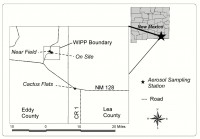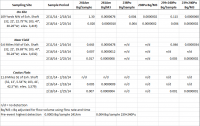The Carlsbad Environmental Monitoring & Research Center, an entity of New Mexico State University, continues to collect ambient air filters, on a weekly basis, from air sampling stations located on and near the Waste Isolation Pilot Plant (WIPP) facility.
The latest results from these air samplers (as of 2/25/14) show that the levels of radioactivity (241Am, 239+240Pu, and 238Pu) have decreased significantly, much lower than the levels observed immediately following the February 14, 2014 underground radiation detection event. Further, the CEMRC’s analyses continue to reflect that the air around the WIPP site is safe – posing no harm to the environment or the public.
Below is a graphic showing the location of the CEMRC’s three ambient air samplers as well as a data table showing the measurements observed at each of the three sampling sites, by isotope, and by time period following the event. As can be seen in the table, the two sites with the highest activity (On-Site and Near Field) initially showed 241Am activities of 1.3 Becquerels (Bq) per sample and 0.645 Bq per sample respectively in the days following the event. The Becquerel is an international measure of activity and is equivalent to one disintegration per second. While these higher activity levels were well below any environmental or public concern, they were significantly higher than what had been previously detected over the past 15 years of air sampling at these locations. Over the ten day period following the event, the activity levels of 241Am detected at the On-Site and Near Field sampling stations decreased by 65 times and 38 times respectively to 0.02 Bq per sample at the On-Site sampling station and 0.017 Bq per sample at the Near Field sampling station. Additionally, the latest results show that the 239+240Pu activities have returned to previous background levels.
The CEMRC continues to collect and analyze 45 air filters per week from in and around the WIPP site consisting of 3 ambient air samples, 21 WIPP pre-filtered exhaust samples, and 21 WIPP post-filtered exhaust samples and will continue to do so until radiation detection levels decrease to near background levels. Lastly, the CEMRC has just collected soil samples from around the WIPP facility and will soon be collecting surface water and sediment samples from the three reservoirs in the area (Brantley Lake, Lake Carlsbad, and Red Bluff Lake). Results from these analyses will be posted on the CEMRC website www.cemrc.org when they are released and will be communicated to local media outlets as well. For more information about CEMRC’s environmental monitoring program call Dr. Russell Hardy, Director, at (575) 234-5555 or email him at rhardy@cemrc.org




